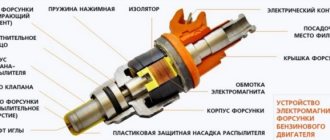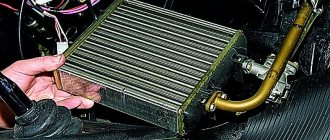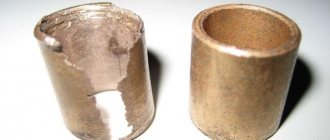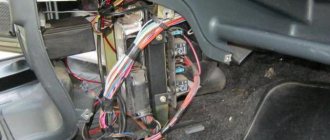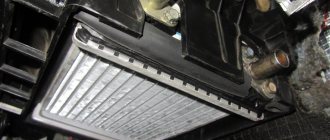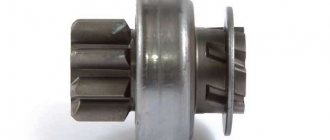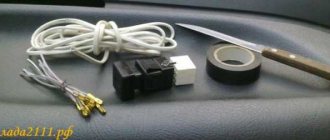A little theory
The heated liquid moves from the thermostat to the tap, and then it either enters the radiator “30” or exits directly into the outlet pipe. These are two different cases corresponding to the extreme positions of the engine (MAX/MIN). If you look at the drawing, everything will become clearer.
This is what the heater assembly looks like
Shown here: 6 – outlet hose; 8 – supply hose; 7 and 27 – clamps (4 pcs.); 26 – internal outlet hose (to the radiator); 28 – supply internal hose (from the radiator), 33 – clamp.
How to correctly replace pipes in a VAZ-2114
The first question that experts hear from car enthusiasts is which pipes should be purchased for the VAZ-2114? Products made from silicone are considered the most durable and at the same time ideally compatible with the cooling mechanism of the VAZ-2114. The diagram below shows the location of the pipes we are interested in:
- The short ones are mounted on the couplings of the thermostat and the pump pumping water.
- Next comes the conductive hose.
- The pipe located in the lower part is responsible for removing antifreeze from the radiator unit.
What set of tools will be needed to replace the VAZ-2114 pipes
- New hoses.
- Keys of different sizes.
- Screwdrivers of different formats.
- Silicone-based lubricant.
Now let’s talk about how the well-known antifreeze differs from antifreeze. The latter is produced by a domestic manufacturer, antifreeze is produced abroad, so the composition may differ.
Preparing for replacement
The negative terminal is disconnected from the battery. Then, using a 10mm wrench, unscrew the 16 screws holding the engine splash guard.
Removing the mudguard is not so easy
Next we will drain the antifreeze. Unfortunately, on a VAZ-2114 there is no other way to replace the faucet. And on the 11183 engine, to do this, remove the ignition module with the bracket (three 13mm key screws). The main thing is to open the cap on the expansion tank, disconnecting the sensor connector from it.
First, the antifreeze is drained from the engine, then from the radiator. Using the “13” key, unscrew the cap on the engine, replace the container... Then we do the same with the radiator cap (see photo).
Two drain plugs
Both plugs will need to be tightened.
The rules for choosing antifreeze were discussed earlier. By the way, when draining old antifreeze, do not leave the stove tap closed.
What to check
Before replacing the faucet, you need to make sure that:
- The network is de-energized;
- The car is secured with a handbrake;
- There is no liquid in the cooling system.
Two drain plugs
What to check
Instructions for replacing the cooling system pipes of the VAZ-2114
Step-by-step replacement of cooling system pipes in a VAZ-2114 car looks like this:
- Remove the battery cable that comes out of the negative socket.
- Carefully drain the old coolant, but wait until the engine has cooled completely before doing so. Otherwise, there is a risk of getting burns from the coolant.
- Remove the following components: set aside the upholstery that provides sound insulation, the fan, the trim going to the windshield frame, the facing material.
- Now your goal is to get to the air collector; to do this, unscrew the brackets in the form of springs and the screws responsible for fixing them. A screwdriver is ideal for spring clips; for screws, you need a wrench.
- To loosen the clamps, remove the front housing, and then remove the old hoses from the fittings.
- All that remains is to install new silicone hoses in a specially designated place; it is preferable that the parts are manufactured abroad - they will last longer.
- Reinstall the other components by following the reverse order of this step-by-step instruction.
Drivers of the VAZ-2114, who replaced the usual factory rubber pipes with silicone ones, note the following advantages of the new components:
- Long service life, and all thanks to the increased wall thickness and dense reinforcement, consisting of several layers of material.
- Silicone hoses work successfully and efficiently, regardless of the temperature and weather conditions outside.
- When the silicone pipe is tightened, a force is felt, so overtightening and damaging the hose, like a rubber one, will not work in any case.
- The engine compartment can be painted any color you like.
Among the disadvantages of silicone pipes built into the cooling system of domestically produced VAZ-2114 cars, drivers note:
- high cost of parts, one set is approximately 1.5-2 times more expensive than rubber analogues;
- the manufacturer does not provide any warranty, so if you bought a defective product, it is impossible to replace it and you will again have to spend money on a new set of hoses.
In order not to pay extra, VAZ-2114 owners prefer to order silicone pipes in online stores, where they are found in 2 types:
- with reinforced thread;
- Along with silicone there is a rubber component.
Despite the possible negative nuances of silicone hoses, the owners of the VAZ-2114, who took the time to modernize their car and changed the pipes in the vehicle’s cooling system, note that the modification is worth the money - the engine is cooled like clockwork, no major comments are made.
As for the service life of new hoses, on average it is 2 years longer than that of rubber pipes, but only when it comes to reinforced silicone components.
Often during repairs, air enters the cooling system, which forms an air lock and interferes with the normal operation of the entire system. In order to remove such a traffic jam, there are several ways. Simplest:
- warm up the engine to operating temperature and turn it off;
- unscrew the coolant pipe clamp on the throttle body;
- remove the heating pipe of the throttle assembly, bleed the air and after the coolant begins to flow out, put it back on the fitting and tighten the clamp.
ATTENTION: the leaking antifreeze has a temperature of more than 90 degrees Celsius.
Dismantling and replacing the stove valve on a VAZ-2114
It seems that to replace the faucet on a VAZ-2114 you need to remove the instrument panel. In reality, it will be enough to remove the side trim piece, as well as the glove compartment. The main rule is to unscrew all the screws that you can see.
Right sidebar
The result of our efforts is what is shown below.
The result of dismantling the cladding
And now you can see two “internal hoses”. What to do next is clear to everyone.
What can you see under the cladding on the right?
Loosen the clamps installed on the faucet side and remove the hoses. By the way, antifreeze may leak here (it is poisonous).
Under the hood
Below, near the partition, you can see two “external hoses”. Loosen the clamps and remove the hoses from the pipes. Next, use a spanner to unscrew the two nuts (see photo).
All the actions performed under the hood
Let's go to the salon.
In the cabin
Without disconnecting the rod, remove the faucet (photo 1). Then immediately remove the “holder” (photo 2). And then, by pulling the assembly outward, it will be possible to remove the mechanical rod completely.
Three final steps
As you can see, everything is simple. Installation is carried out in reverse order.
Under the hood
Let's go to the salon.
In the cabin
Three final steps
Selecting a replacement radiator
But before you begin the removal and replacement operation, you should first select a new heat exchanger.
You can buy a factory heater radiator, catalog number 2108-8101060. But analog products made by DAAZ, Luzar, Fenox, Weber, and Termal are also quite suitable.
As for the material, it is recommended to use copper heat exchangers, but they are much more expensive than aluminum ones. Although this is not an acquired taste, many people use aluminum products and are quite satisfied.
In general, the main thing is that the radiator is designed specifically for these cars.
The designers used the same front panel design on the VAZ-2113, 2114 and 2115 models, so the replacement algorithm is the same for them.
Next, we’ll look at how to remove the radiator of the interior heating system using the example of a VAZ-2114, and how this is done in different ways.
Subtleties of filling new antifreeze
Before you start filling in new coolant, you need to drain the old one, and also thoroughly clean the entire cooling system of contaminants. To do this, it is better to use a special cleaning agent that can be purchased at a car enthusiast store. Make sure that all taps and plugs of the VAZ-2114 are open. You can determine whether the system has been flushed or not based on the color of the antifreeze flowing out.
The plugs and tap are closed only when the product becomes transparent. If the manufacturer describes in the instructions the specifics of using the cleaning mass, follow these rules for effective cleaning. As for the level of antifreeze filling, some drivers prefer to fill to the limit mark, others deliberately do not top up, and later, after a successful test, add more fluid.
After the antifreeze has been replaced, all that remains is to close the expander and start the car engine. The motor should idle until the furnace fan starts running.
How to correctly replace pipes in a VAZ-2114
If only the regulator is faulty, then replacement is not necessary. But if the engine is stuck in the “Cold” position, the liquid in the stove stagnates. And in this case, it would be advisable to perform a replacement. Well, if the tap is leaking, then it is clear that you cannot continue to operate the car - the engine may overheat.
You will need a pit to work with because the heater valve is located at the bottom of the hood, under the side trim on the passenger side. Replacing the stove valve on a VAZ 2114 is carried out in several stages:
- On the faucet, you need to brush the fasteners, rinse them with brake fluid, and leave them for a while so that the fluid cleans the threads on the studs and the nuts are easier to unscrew. To wash studs, it is better to use WD-40, if available. This is an important stage in the work, because rusted bolts can grab the nut so much that unscrewing them becomes problematic. Sometimes when unscrewing nuts, the bolts need to be held with an additional wrench or pliers.
- In the cabin, remove the side trim. Now you can see the pipes leading to the tap. Loosen the hose clamps and remove the hoses one by one. At the same time, keep a container with antifreeze near you, which you immediately place under the emptied pipes so that the remaining antifreeze flows out.
- If you decide to replace the hoses, they must also be released from the radiator. But if they are in satisfactory condition, then when you start assembling, you will only need sealant.
- Return to the pit and use a 10mm wrench to unscrew the nuts holding the tap in place.
- Go back to the body again and try to remove the heater valve of the VAZ 2114 towards the passenger seat. In this position, remove the lock and release the cable that controls the tap.
- Now you can install the new faucet. First put the cable on it, secure it with a spring clip, and only then can you screw it into place. Install O-rings between the valve and the body. Use sealant to secure the stove pipes in place. Don't forget to pour the antifreeze back into the radiator at the end.
Replacing the stove valve of the VAZ 2115, as well as the VAZ 2113, is carried out in the sequence described above. The design of the heater in these VAZ models is the same as that of the VAZ 2108.
HEATER RADIATOR
If it turns out that the heater radiator on a VAZ 2114 needs to be replaced, first of all you need to find out where it is and how to get to it. The heater radiator on the VAZ 2114 is located below the instrument panel on the right passenger side in the car interior. The design of the model 2114 stove is fundamentally no different from the heating system diagram of any other car. The VAZ 2114 stove consists of the following elements (stove diagram):
- Main body (the radiator and heater motor are mounted on it);
- Motor (located on top of the body, dismantled from above, from the engine compartment);
- Two pipes;
- Air ducts. They are located along the entire length of the instrument panel. There are also air ducts in the lower part, they are needed to heat the feet of front and rear passengers;
- Heater radiator;
- Stove tap.
Heater tap
The heater radiator is relatively inexpensive, prices depend on the manufacturer and region of sale. In addition, the parts differ in the material of manufacture, that is, they can be copper (brass) and aluminum. A copper radiator is more expensive (ranging from 1400-2000 rubles), and it is believed that it has the following advantages:
- Greater heat transfer (that is, it will be warmer in the cabin);
- Maintainability (it is possible to solder it if a coolant leak is detected).
An aluminum radiator is cheaper (700-1000 rubles) and does not transfer heat to the interior as efficiently. But this is only in theory. If you go to car enthusiast forums on the Internet, you can “hear” from users the opinion that copper is actually less effective. In fact, it turns out that the copper stove practically does not heat the engine at idle speed, and at these speeds the car has to work quite a lot in winter.
Among the manufacturers of VAZ radiators it is worth noting:
- Copper products – OR LLC (Orenburg) and SHAAZ;
- Brass - DAAZ, LUZAR and KRAFT.
A new radiator should be chosen carefully, since replacing it is quite labor-intensive for a car enthusiast.
Moreover, if you perform this procedure yourself for the first time, it will seem long and tedious to you. Car repair shops charge from 1,500 to 2,000 rubles on average for replacing a radiator and do the work quite quickly.
When purchasing spare parts, there is always a risk of buying a fake. To avoid such a purchase, you should adhere to certain rules:
- Do not buy a product whose price is suspiciously low;
- Ask sellers for a certificate for the product;
- Try to purchase spare parts in original packaging.
Buy goods from well-known manufacturers (in packaging with documents).
If the product is suspicious, you can always refuse it. Now there is no shortage of spare parts for the VAZ 2114; if in doubt, it is better to buy a heater radiator elsewhere.
Another video with an example of replacement
The stove valve in the car opens or blocks access to warm air into the car body, thereby regulating the heat supply to the cabin. Sometimes the heating and cooling system refuses to function properly, stops supplying heat, or supplies it in unlimited quantities. What this may be connected with and how to eliminate such malfunctions, you will find out below.
A working faucet is the key to a warm car interior
The VAZ-2114 car uses a hidden engine cooling circuit with an injector. It is highly complex and includes 28 elements. Traditionally, the assembly of the cooling system of this car is not of high quality. Therefore, throughout the entire period of operation, it requires constant monitoring, regular maintenance and repair.
- 1. How to properly replace the coolant mixture?
- 2. How to flush the cooling system?
- 3. How to remove air from the VAZ-2114 cooling system?
- 4. How to properly replace the cooling system pipes?
WHY DOESN'T THE OVEN TAP WORK?
Under the hood
Let's go to the salon.
In the cabin
Three final steps
Under the hood
Let's go to the salon.
In the cabin
Three final steps
One of the reasons for a non-working faucet is souring. As a result of corrosion under the influence of chemical liquids, the flag loses its mobility, and the tap stops opening or closing. If this happened when the tap was open, then warm air will flow inside even when no one needs it.
Sometimes a failed heater faucet in a VAZ 2114 leads to air in the system, the stove does not heat, and cold air enters the cabin.
But the most common defect is a leaking stove tap. Antifreeze gets into the car body and stains the floor mats. In both the first and second cases, it is necessary to replace the VAZ 2114 heater valve.
All owners of VAZ 2114, 2115 and other models unanimously claim that the original faucets that are equipped with the stoves of these cars are the most unreliable. The locking mechanism is a rubber membrane. Aluminum housings are susceptible to corrosion and quickly turn sour. True, the price of these parts is low - 80-120 rubles. Apparently, the price is calculated on the fact that the faucets will change every season.
Ceramic faucet is considered the most wear-resistant
But car owners don’t want to crawl under the car every time it gets cold, spoil their shoes with leaking antifreeze, and freeze inside the car. Yes, and this is a troublesome task - replacing the faucet on the VAZ 2114 stove. Therefore, motorists give preference to more reliable models of faucets:
- ceramic, their locking mechanism is made of ceramic plates, and the body is made of high-quality plastic;
- Ball valves, the locking element of which is a ball with holes.
Most VAZ 2114 owners prefer the Yavva ceramic faucet as one of the highest quality and most reliable. Although these models have lower heat transfer than ball models. The latter are susceptible to oxidation, but to a lesser extent than the duralumin models of AvtoVAZ cranes.
This malfunction occurs as a result of the heater housing drying out or due to souring of the shut-off device. The last reason is usually a consequence of the car being idle for a long time. In order not to damage the faucet or break the control cable, in such cases it should be opened very carefully, without using excessive force.
When the stove dries out, it is often not possible to diagnose the malfunction in time, since the leak may be minimal. But over time, the coolant leaking from the stove will certainly make itself felt. The first obvious sign of this malfunction is the appearance of a puddle on the floor of the car in the area of the passenger seat closer to the center panel. A driver or passengers with a good sense of smell can sense a characteristic odor before a puddle appears, which will only increase.
Another nuisance when the heater tap leaks is the formation of a thin oil deposit on the windshield, which appears as a result of evaporation of the coolant. At night, or when the sun shines directly into the driver's eyes, this can cause problems with the quality of vision, making it difficult to make the right decisions in a timely manner when the traffic situation changes.
To replace the faulty faucet of the VAZ-2114 stove, we will need 10/13 wrenches (socket ones will work much more conveniently), rags, a Phillips-head screwdriver, and a container for draining the coolant. Dismantling algorithm:
- we drive the car onto an overpass/inspection hole, place a prepared container with a capacity of about 5 liters under the drain hole, unscrew the plug and wait until all the antifreeze is drained;
- We look in the engine compartment for the pipes connecting the power unit to the tap, use a screwdriver to loosen the fastenings in the form of clamps, and remove the pipes;
- go to the interior, unscrew the screws that secure the left panel cover;
- on the right side under the panel we find the heater tap, to which the pipes from the engine compartment are connected, put a rag under them and use a screwdriver to remove both pipes;
- go back to the engine compartment, find the studs on which the faucet is attached to the car body, unscrew the bolts with a 10mm wrench;
- now nothing is holding the crane, we go into the interior and pull it out, disconnecting the drive fastening cable;
- We attach the cable to the new tap, install it in its original place and reassemble it in the reverse order.
Replacing the tap
Under the hood
Let's go to the salon.
In the cabin
Three final steps
Under the hood
Let's go to the salon.
In the cabin
Three final steps
It was said above that one of the reasons for the appearance of antifreeze in the car interior may be leakage from the heater radiator.
Below you will learn how to replace a leaking heater radiator. First of all, of course, you need to drain the antifreeze. Then you get comfortable in the cabin and begin to disassemble the front panel: glove compartment, consoles, sides. Unscrew all the screws and screws. To avoid losing them, collect them on a magnet or in a small plastic cup. There is one hidden screw under the plug on the dashboard console, so be careful.
When you remove all the panels and access to the heater radiator opens, loosen the clamps on the pipes, release them, but do not forget to place a mug or other container under the hoses so as not to flood the interior with antifreeze residue. Now you have to remove the VAZ 2114 stove, or rather, the heating radiator.
Assembly is done exactly the opposite. Install the new radiator in place. Experienced drivers recommend lubricating the fittings with soap to make the rubber pipes easier to put on. It is recommended to install new clamps for them, purchasing them together with the radiator. Also install the panel, glove compartment and other parts in the reverse order.
When pouring antifreeze, check that no air pockets form. To do this, remove one of the hoses leading to the throttle valve and release the air. Reattach the hose to its place.
Don't forget about the air lock when replacing antifreeze
If you did everything correctly, there will be no more antifreeze leaks, and the cabin will become warm and comfortable.
If owners of classics quite often complain about malfunctions of the interior heater, then the VAZ-2114 stove in this regard works quite stably, coping “well” with its immediate responsibilities. If the interior is in good condition, even in severe frost, the stove will be able to provide a comfortable temperature, and ice on the windshield will be removed within a few minutes.
The most common causes of radiator failure are:
- depressurization of the device;
- clogged tubes.
When clogged, the internal radiator tubes become covered with deposits, narrowing their clearance and impairing the circulation of coolant. Clogging most often occurs as a result of using poor-quality coolant. The advanced age of the car also leads to the appearance of this problem, as does the entry of dust, dirt, water, and friction products of the power unit into the heating system.
The appearance of a leak in the radiator is a consequence of mechanical damage, corrosion processes and drying out of the material from which the radiator tubes are made. In this case, a decrease in the volume of antifreeze leads to an increase in its temperature and a deterioration in engine cooling, as evidenced by the readings of the temperature sensor.
The second reason for the inability to change the heater operating mode is a malfunction of the switch itself. True, its failure is a rather rare phenomenon, occurring due to oxidation of the contact surfaces.
It is quite possible to clean the radiator pipe system from deposits and scale. To do this, you can use the same cleaning products that are usually used in everyday life (“Silit”, “Mole”, Comet). However, any chemically active compositions will do, including Coca-Cola (you’ve probably repeatedly seen materials devoted to this drink regarding its chemical properties).
As practice shows, better results can be achieved by working with the radiator removed, but this is not critical. Completely satisfactory cleaning can be performed without dismantling the radiator. The flushing scheme is very simple: the antifreeze is drained, all pipes are disconnected, after which a cleaning agent is poured into the filler neck. Then the engine starts, which, with the heater on, should idle for about 40 - 120 minutes.
After cleaning, the radiator is thoroughly washed, for which you can use running water from a tap connected through a suitable hose. The final stage is to dry the radiator with compressed air (if a compressor is available) or naturally, which will take at least a day. The presence of a leak is a much more serious problem.
Soldering is also difficult, since the radiator tubes are made of aluminum. For such work you need a very powerful soldering iron, supplemented with special solders and flux. The quality of soldering also depends on the skills of the worker performing such repairs: if they are small, there is a high probability that over time the leak will be restored in the same place. Therefore, it makes sense to replace the radiator with a new one, the cost of which varies within a thousand rubles.
If you believe the VAZ-2114 manual, then any radiator repair is impossible without removing the panel. In reality, only partial dismantling of the panel is required. A set of tools required for this operation:
- Phillips head screwdriver;
- wrenches (wrench or socket) for 7/10/13;
- rags;
- containers with a volume of 5 liters or more for draining antifreeze from the VAZ-2114 cooling system;
- a small but wide container for draining antifreeze from the stove radiator;
- high density polyethylene film.
Instructions on how to remove the stove on a VAZ-2114:
- We install the car on an overpass or other place with good access to the bottom of the engine compartment.
- Remove the negative terminal from the battery.
- Remove the motor protection, which is held in place with 10mm bolts.
- Drain the coolant by unscrewing the bolt plug (after placing a prepared container under it) with a 13 key.
- Unscrew the screws that hold the radiator in place and remove it.
- We install a new radiator and perform all operations in reverse order.
As you can see, you will have to tinker a lot, the main thing is to adhere to the specified sequence of disassembly and assembly.
"Folk" way
Folk craftsmen - these are brave and very desperate craftsmen - offer a much less labor-intensive method. The bottom line is that replacing the stove pipes (and the stove itself) is done without draining the coolant and without dismantling the instrument panel. The tools you will need are a set of screwdrivers, rags and a container (small) to drain the liquid from the pipes. In this case, replacing the heater radiator pipes is carried out according to the following scheme:
- Removing the terminals from the battery
- Close the heater tap
- We remove the right front seat (to make it easier to do the work)
- We unscrew the two screws securing the dashboard on the right side, and one screw located in the glove compartment, then, pulling the dashboard towards you, we place a wooden block
- Now there is a gap on the side of the passenger seat and you can get to the pipes and to the heater radiator itself
- Lay a rag on the floor of the cabin and prepare a container to collect the coolant
- Which will spill from the radiator and pipes
- We loosen the clamps of the pipes (photo above) and carefully, one by one, remove them from the radiator, replacing the container. 200 - 300 grams of coolant will drain into it
- Replace the pipes with new ones, and change the clamps, just in case.
- If necessary, unscrew the three bolts that secure the radiator to the stove and pull it down to the right
- We install the pipes and the new radiator in the reverse order.
Briefly about the car
The VAZ-2114 hatchback is a fairly popular car that can still be found both on domestic roads and on the roads of the entire post-Soviet space. It was produced by AvtoVAZ OJSC from 2003 to 2013 and was one of the variants of the restyled series of the Samara-2 (VAZ-21093) family of cars.
During mass production, various engines with the same type of cooling systems were installed on it, which operate on the principle of internal heat exchange using a special cooling mixture of the “Tosol” type.
Cooling system diagram
Product delivery options
Note! Below are the shipping methods available specifically for this product. Payment options may vary depending on the shipping method. Detailed information can be found on the “Delivery and Payment” page.
Parcel by Russian Post
Available payment methods:
- Cash on delivery (payment upon receipt)
- Using cards Sberbank, VTB, Post Bank, Tinkoff
- Yandex money
- QIWI
- ROBOKASSA
Shipping throughout Russia. Delivery time is from 5 to 12 days.
Parcel by Russian Post 1st class
Available payment methods:
- Cash on delivery (payment upon receipt)
- Using cards Sberbank, VTB, Post Bank, Tinkoff
- Yandex money
- QIWI
- ROBOKASSA
Shipping throughout Russia. Delivery time is from 2 to 5 days. More expensive than regular delivery by Russian Post, approximately 50%. Parcel weight up to 2.5 kg
Express Parcel EMS
Available payment methods:
- Cash on delivery (payment upon receipt)
- Using cards Sberbank, VTB, Post Bank, Tinkoff
- Yandex money
- QIWI
- ROBOKASSA
Shipping throughout Russia. Delivery time is from 3 to 7 days. More expensive than regular delivery by Russian Post, approximately 100%.
Transport companies
Available payment methods:
- Using cards Sberbank, VTB, Post Bank, Tinkoff
- Yandex money
- QIWI
- ROBOKASSA
Delivery is possible to any locality where there is a representative office of the transport company. Delivery time is from 2 to 10 days. Sending large parcels is approximately 50% more profitable than by Russian Post.
Courier delivery in Togliatti
Available payment methods:
- Cash upon receipt
- Using cards Sberbank, VTB, Post Bank, Tinkoff
- Yandex money
- QIWI
- ROBOKASSA
Delivery time from 1 to 12 hours.
Pickup from our warehouse
Available payment methods:
- Cash upon receipt
- Credit, installments
- Using cards Sberbank, VTB, Post Bank, Tinkoff
- Yandex money
- QIWI
- ROBOKASSA
Pickup times must coincide with store opening hours.
The device of the VAZ-2114 stove
Before we deal with the operation of replacing the VAZ-2114 heater, let’s consider its structure and operating principle. The interior/windshield heater is located in the instrument panel (dashboard) area under the center console. All elements of the device, with the exception of deflectors and heater control handles, are hidden inside the panel. Main components of the stove:
- radiator;
- casing;
- inlet/outlet pipes;
- tap;
- electric motor with impeller;
- main damper;
- driver/front passenger foot air damper;
- heated windshield flap;
- control module (operating mode switch handle, damper control knobs, resistor).
The operating principle of the heater is based on the use of heat exchange processes between the coolant and the atmospheric air entering the car interior. The main element of the heating device is a radiator with a system of tubes through which coolant circulates. When cooling the power unit, the liquid heats up, which allows the tubes to be equipped with special lamellas to release heat, heating the air.
An electric fan is built into the radiator, the main purpose of which is to pump air into the system. The intensity of the air flow entering the car interior can be adjusted using a switch located on the central panel of the VAZ-2114. It changes the resistance of the built-in resistor, thereby allowing you to reduce or increase the fan speed.
The air flow, passing between the lamellas of the radiator tubes, is heated in the body of the VAZ-2114 stove and enters the cabin through the air ducts. The central damper allows you to regulate the flow of air into the cabin (when the damper is completely closed, the air supply is blocked). Two other flaps allow you to change the direction of air flow when blowing the windshield and feet. Although the stove is an integral part of the car's heating system, it can be completely turned off by turning off a special tap.
What's the result?
As you can see, removing the VAZ 2114 stove with your own hands and replacing it is actually not difficult. Basically, the difficulties are associated with the need to remove elements of the dashboard. If you are not confident in your abilities, it is better to refuse this operation and entrust the work to experienced specialists.
If you decide to change the heater radiator or heater faucet of the VAZ 2114 yourself, then it is important to mark or sign all connectors and contacts so that after putting the instrument panel back in place there will be no problems with the functionality of buttons, controls, etc.
Although the VAZ 2114 is a budget car, it is simply impractical to perform the procedure for replacing the heater radiator every 2 years or even earlier due to the use of cheap components.
In turn, by installing good quality parts (radiator, pipes and faucet), as well as securely securing all connections with sealant, you can count on no leaks for 5-6 years, as well as normal operation of the stove as a whole.
Antifreeze boils and bubbles in the expansion tank. Causes of antifreeze or antifreeze boiling, main faults, troubleshooting, recommendations.
There is air in the engine cooling system: symptoms of airing, reasons for the formation of an air lock. How to bleed the engine cooling system.
The VAZ 2110 heater does not work: the main reasons why the VAZ 2110 stove does not heat well. Diagnostics, replacement of VAZ 2110 heater radiator, modification.
When and why you need to flush the engine cooling system. Available flushing of the cooling system with citric acid, proportions for preparing the solution.
How to change the heater radiator on Kalina: the recommended method, as well as replacement without removing the dashboard. Choosing a replacement radiator for the Kalina stove.
Heater VAZ 2107: heater design, modification of the stove 2107, main malfunctions of the stove. Repair of the VAZ 2107 stove, tips and recommendations.
Maintenance
Regular maintenance of the cooling system comes down to checking the level of the coolant mixture in the expansion tank and monitoring its color. It is recommended to check before each trip or, in extreme cases, regularly every 500 - 600 km.
The level of the coolant mixture in the tank must constantly exceed the minimum level by 2...3 cm. Checking the level and adding fluid must be carried out only on a cold engine. The mixture intended for topping up must be of the same type as the liquid poured into the system. Mixing different types is not recommended.
Possible malfunctions of the VAZ-2114 stove
https://www.youtube.com/watch?v=ZFJrh_oKTpQ
Despite the fairly simple design of the heater, some of its elements may fail over time. At the same time, the probability of failure of the heating system as a whole is quite small. The most common stove failures include:
- problems with the radiator;
- faucet leak;
- wear of pipes;
- resistor failure;
- switch malfunctions.
Let's look at each fault block in more detail.
As noted above, the resistor is designed to change the level of resistance of the current supplied from the generator to the heating system fan. In the VAZ-2114, using a switch, you can ensure the fan operates in three modes. In the extreme position, the fan is powered by a voltage equal to the nominal voltage of the vehicle's on-board network, providing maximum power output.
In the intermediate position of the switch, the level of the supplied voltage is reduced due to one of the two resistor windings, the resistance of which increases by 0.20 Ohms. In the third mode, the second winding also comes into operation, due to which the total resistance of the resistor increases by 0.80 Ohms, reducing the fan rotation speed to a minimum.
If the windings burn out, regardless of the switch position, the fan operates only at full power. The inability to switch fan operating modes is evidence of a resistor malfunction.
Causes of breakdowns and repair of the car heater
- A leak of antifreeze or other liquid used to fill the radiator causes corrosion of both the stove itself and its individual parts, for example, the tap. If the cause of the problem lies in a broken faucet or pipe, then you can limit it to replacing them without resorting to “opening” the stove itself. If a copper radiator malfunctions, the leak in it should be soldered by an experienced radiator specialist. Aluminum structures cannot be repaired; they must be replaced with new ones.
- When the heater is running, it blows out cold air. The source of this breakdown lies in a clogged or broken tap. It is through it that the air is heated. It can be cleaned, blown out or replaced with another one.
Replacing the radiator of various brands of cars requires the use of professional tools and qualified specialists. Repairing or replacing the heater yourself can lead to damage to other parts of the car, which can significantly increase the cost of repairs.
Flushing the system and replacing the coolant
Repairs related to replacing the coolant on a VAZ-2114 car are carried out if:
- The color of the mixture in the expansion tank has changed. This usually happens after 20 - 40 thousand kilometers;
- repairs were carried out that required a complete drainage of the mixture.
In general, coolant replacement is carried out in the following order:
- 1. Completely drain the cooling solution. To do this, you need to open all the plugs and taps, and also remove the radiator and expansion tank caps. Drain the mixture only after the engine has cooled down (In a hot engine, the temperature of the solution can be more than 100 degrees Celsius).
- 2. Rinse the cooling system with distilled or clean water. Begin the washing procedure after all the old mixture has drained. It is recommended to flush the engine block and radiator with warm water. Otherwise, it is recommended to fill in cold water, warm up the engine, and then drain the water. The color of the water determines how dirty the system is and repeats the flushing process until the flowing water becomes clean. Only after this they begin to replace the mixture.
- 3. Pour a new cooling solution into the system, having previously closed all plugs and taps. Pour liquid into the tank in a thin stream until the maximum mark is reached. Air pockets are not allowed. Then the expansion tank and radiator caps are closed. In order to prevent the rubber pipes from drying out, they must be lubricated with silicone grease.
- 4. Start the engine and let it idle until the heater radiator fan turns on. After this, you can turn off the engine and, after cooling, check the fluid level in the tank. If the fluid level has not changed, then everything is normal and the work is completed. If the liquid level in the tank has decreased, you need to make sure by visual inspection that there are no leaks. If they are not there, then add fluid, start the engine again and repeat the test.
The cooling system of the VAZ-2114 car uses 4 rubber pipes:
- upper supply pipe - supplies cooled liquid from the radiator to the engine;
- lower outlet pipe - removes the heated liquid below from the engine to the radiator;
- two short pipes that connect the water pump and thermostat to the system.
If the pipes fail, they must be replaced. In this case, it is best to purchase silicone pipes.
To remove old and install new silicone (rubber) pipes, you need a set of wrenches, several screwdrivers and silicone lubricant.
Repairs associated with replacing pipes must be carried out in the following order:
- 1. Disconnect and remove the battery;
- 2. Drain all coolant mixture;
- 3. Remove the fan, soundproofing upholstery, trim and frame trim from the windshield;
- 4. Clear access to the air collector by removing its fastening elements;
- 5. Remove the front housing and release the clamps that hold the pipes;
- 6. Remove the pipes from the fittings and install new ones (silicone or rubber) in their place. Secure the new pipes with clamps. Before installation, it is recommended to lubricate the rubber pipes with silicone grease. It is also advisable to lubricate the clamp screws with silicone grease. Subsequently, this will allow you to easily unscrew them;
- 7. Install all the removed parts in their places, flush the system and fill it with new coolant mixture.
Work order
Replacing the radiator of a VAZ-2114 stove without removing the dashboard allows you to save time, and this does not require any special skills. Let’s immediately make a reservation that part of the torpedo will still have to be disassembled, but the center console will remain in place, and this is the most labor-intensive part of the operation. At the initial stage of work, the side part of the panel on the passenger side is removed; to do this, use a screwdriver to unscrew the screws securing it.
To drain the coolant, you need to unscrew the bolts of the front protection, which is located under the engine compartment. The antifreeze is drained through a special plug located in the cylinder block; to unscrew it, you will need a 13 mm spanner. To prevent it from spilling on the ground or the garage floor, a container is placed under the car. To increase the rate at which antifreeze flows out, you can open the cap of the expansion tank.
Using a hexagon on the passenger side, the torpedo mount is unscrewed, after which it can be easily bent.
Next, you need to unscrew another fastener, located on the passenger side under the lower part of the center console. After this, the torpedo can be easily raised so that it remains in the same position, a stop of suitable length can be installed under it; a block with a cross-section of 50x50 mm and a length of about 40 cm is enough.
In the opened space you can see the heater radiator, which is attached to three self-tapping screws. They must be unscrewed so that it can be safely removed from the socket. In this case, a problem will arise - another self-tapping screw is hidden behind the plastic body of the torpedo, which needs to be unscrewed. To get to it, it is advisable to drill a small hole in the plastic through which you can insert a screwdriver. To do this, you first need to remove the glove compartment. If you try to move the torpedo, you can break the plastic and then removing the heater radiator on a VAZ-2114 will turn into an expensive procedure.
Next, you can proceed directly to dismantling the heater radiator. To do this, remove the clamps and disconnect the pipes, under which it is better to place a small container or rag, since there is still antifreeze in the system, which will spill directly into the cabin. After this, the radiator is removed from the mounting socket without any effort. It is advisable to examine it to see where the damage was and where the antifreeze is leaking from; corrosion damage appears in this place and streaks are visible, which once again confirms that the stove radiator needs to be replaced.
The new heater core fits into place effortlessly and should not cause any problems. It is secured with self-tapping screws, including through a hole previously drilled in the dashboard. In this case, it is advisable to inspect the faucet, since this is another weak point of the heating system. It should be completely dry and the lever should be easy to turn. The glove compartment is installed in place, the dashboard and the removed side panel are screwed to the mounts.
Before adding coolant, you need to check whether the plug on the cylinder block is tightened so that the coolant does not spill out. Fresh antifreeze is poured into the expansion tank to the level; if during operation the level drops, it will have to be topped up.
To carry out the tests, you need to start the engine and, after waiting until it warms up, turn on the heater. It should heat well in different modes, and the interior should remain dry, without stains of spilling antifreeze with a characteristic odor. At first, it is recommended to periodically look at the floor to make sure that all connections are tight and the new radiator is not defective.


